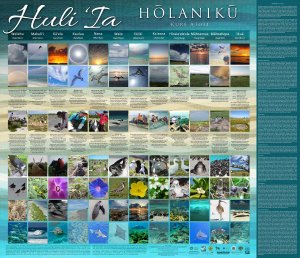Huli ‘ia is an observational process documenting seasonal changes and shifts across entire landscapes, ma uka to ma kai (from the mountains to the ocean). Developed by Na Maka o Papahānaumokuākea, the Huli ‘ia process documents these natural changes over time, identifies dominant cycles of important species or natural occurrences (e.g. flowering, fruiting, presence/absence of flora/fauna, cloud formations, spawning or recruiting of fish species, etc.), and assists in identifying any correlations between species and occurrences. Those correlations help to identify the occurrence of a less visible situation (e.g. fish spawning) when a more obvious one happens (e.g. a flower species blooming). Natural cycles can then be used to support and guide management practices, rather than relying simply on the time of year, which has become more problematic as a management indicator with natural shifts due to climate change. Using natural cycles for decision-making provides a needed flexibility to ensure the best choices of when to harvest and when to allow areas and species to rest. Huli ‘ia strengthens the kilo (observer) in community members and supports the cultural practice of kilo, establishes and deepens intimate relationships between people and place, and provides communities with guidance to support sustainability, health and wellness, and mālama ‘āina (participation in caring for our resources).
An important product of huli ‘ia is a seasonal calendar showcasing the dominant natural cycles and their correlations. These compiled cycles provide us with a timeline of place and a well-documented resource to guide discussions and implementation of best practices in support of these cycles and, ultimately, their productivity. The seasonal calendar also includes ‘ōlelo no‘eau, a traditional system of transferring knowledge through wise and easily remembered sayings. Based on their monitoring activities, participants compose a new, contemporary set of ‘ōlelo no‘eau that capture the knowledge of today by using a traditional mechanism to pass information to the next generation. This huli ‘ia seasonal calendar applies an innovative approach to repair, maintain, and improve natural resources by encouraging awareness and consciousness of participants and the community at-large. Ideally, this will support best practices and improve the health of natural resources.


